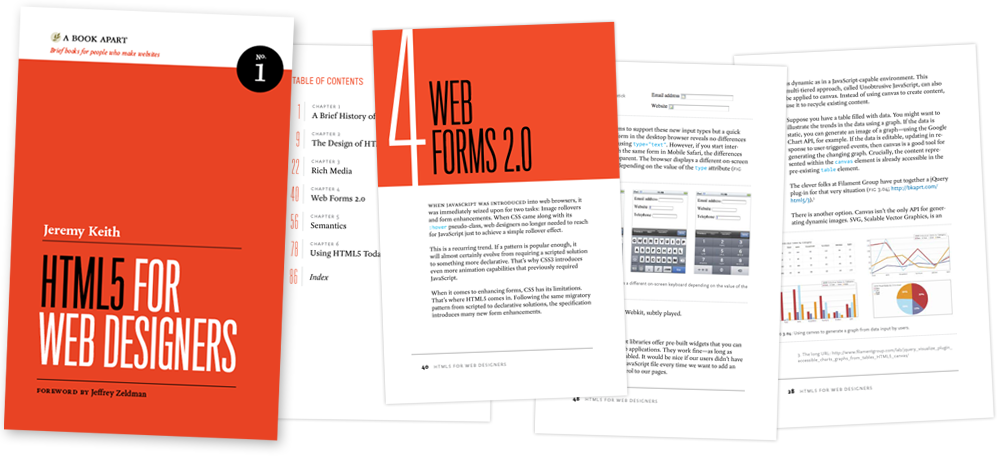HTML5 for Web Designers, written by Jeremy Keith, is the first cheap cialis online book to be published under the A Book Apart brand, founded by Mandy Brown, Jason Santa Maria, and Jeffrey Zeldman.
When the book first landed on my doorstep, I was a bit let down by its meagre length of around 85 pages. I have to be honest, however, and admit I had not done my research before its arrival. From the book’s inception, the publishers stated that they intended to produce something to fill the gap between a blog post and book, something that people would be able to pick up, read quickly, and start implementing straight away.
So I set aside my disappointment and started reading this beautifully crafted book.

After reading through it, my opinion has changed. I realise exactly what A Book Apart were aiming to create when they decided on a short format for the series. HTML5 for Designers is split up into six bite-size chapters:
- Chapter One: a brief history of markup
- Chapter Two: the design of HTML5
- Chapter Three: rich media
- Chapter Four: web forms 2.0
- Chapter Five: semantics
- Chapter Six: using HTML5 today
To give you some insight each chapter’s topics, I’ve described them each briefly.
Chapter One
The first chapter lays out the foundations of the book and explains how, as a community, we arrived at the latest iteration of our favorite markup language, HTML5. Keith discusses how HTML was born, the ill-fated transition from HTML to XML (which never happened), the suggestion of XHTML2, and why we write “HTML5″ instead of “HTML 5″.
You might be tempted to skip straight to the second chapter, but I firmly believe that you should read this. It’s vital material, and you’ll almost certainly learn something. (I sure did!)
Chapter Two
Chapter two discusses how to convert web pages from XHTML 1 to HTML5. It also touches on elements that changed in HTML5 and some elements that are absent from the specification.
Chapter Three
In chapter three, the book delves into the realms of rich media and what it means for designers and developers. Keith hints that this chapter could have a whole book dedicated to it (perhaps hinting at an upcoming A Book Apart title?). He does a good job describing the possibilities of <canvas> and showing a few examples of its capabilities. Although some readers may wish for more depth, this book is of course written for designers, so detail is kept to a minimum.
Keith goes on to explain the possibilities of the <audio> and <video> elements, something which many argue will change the way we work with the web. Keith gives great examples on how to introduce these elements into your client work with various fallback options for browsers that lag behind.
Chapter Four
In chapter one, it’s explained that HTML5 started life as Web Apps 1.0 and Web Forms 2.0, which were later merged. So as one might imagine, Web Forms were destined to become an integral part of the HTML5 specification.
Chapter four covers the new elements and attributes for use in forms, including placeholder, required, autocomplete, datalist, new input types, sliders/spinners, and dates and times.
Chapter Five
Chapter five covers semantics (although I feel that this should have been one of the first chapters in the book). Elements discussed include <mark>, <time>, <meter>, and <progress>, as well as the usual structural elements that get used in nearly every site.
Chapter Six
Finally, chapter six discusses the most important question about HTML5: Can we use it today? I trust, as you are on this website, that you will already know the answer to that question.
My opinion of HTML5 for Web Designers
After finishing this book, I discovered that it is in fact quite a gem for anyone starting on their HTML5 journey.
There are undoubtedly areas that could have been expanded further, but the limitations imposed by the authors meant merciless fat-trimming. This is the type of book that you would be happy to keep on your desk as a quick reference manual, a shortcut before diving into the full HTML5 specification.
I would definitely recommend buying this book if you haven’t already. It’s true that great things come in small packages!

11 Responses on the article “Reviewing HTML5 for Web Designers”
This book has just arrived on my desk and I will be working my way through it soon.
Chapter “Fix” should be “Five.” Thanks for the nice rundown of the book.
Thanks for the typo spot, all sorted now.
Thanks, Jack. The cheque is in the mail.
Thanks for the thoughtful review.
Thanks for the thoughts on this book and all the fab work you guys do. I’ve just ordered “Introducing HTML 5” by Bruce Lawson & Remy Sharp – looking forward to it arriving.
I have been eagerly awaiting my copy and it just arrived. I’m not normally compelled to write reviews of technical books I read, mainly because I don’t read them all at once and they usually just lie around my apartment as an every-so-often technical resource (when Google turns up nothing).
Just the review I was looking for. Thanks!
Been really enjoying “Introducing HTML5″. Bruce and Remy have done a great job.
Awesome book, love it.
I’m reading the book now and I love it. Jeremy is straight and to the point with his explanations. I like how small it is because it makes it easy to read with a busy schedule. Over all I think it’s a great introduction to HTML5
Leave a Reply to Ian Devlin